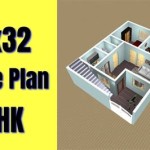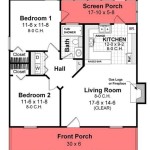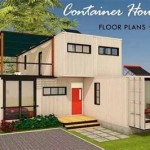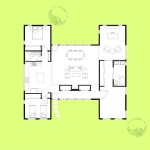```html
Discover Unique One-Story House Plans: Design Your Dream Home
One-story house plans, also known as ranch-style or single-story homes, offer a compelling alternative to multi-level dwellings. They cater to a diverse range of needs, from accessibility concerns to aesthetic preferences, providing a flexible and popular option for prospective homeowners. The enduring appeal of one-story living lies in its convenience, inherent safety features, and adaptability to various lifestyles and lot sizes.
This article explores the unique characteristics of one-story house plans, highlighting factors to consider when selecting a design, and providing insights into how to create a personalized and functional living space. Understanding the nuances of one-story home design allows individuals to make informed decisions and ultimately realize their dream home vision.
Advantages of One-Story House Plans
One of the primary advantages of single-story homes is their accessibility. With all living spaces on a single level, there are no stairs to navigate, making them ideal for individuals with mobility limitations, families with young children, and those planning to age in place. This eliminates the risk of falls and allows for easier movement throughout the home.
Beyond accessibility, one-story homes often foster a greater sense of connection between indoor and outdoor spaces. Because all rooms are on the ground level, it's easier to incorporate features such as patios, decks, and gardens, creating a seamless flow between the interior and exterior. This design element promotes a relaxed and integrated living experience.
Construction costs can sometimes be more predictable with one-story homes. While the foundation may be larger compared to a two-story home with the same square footage, the simplified construction process, particularly concerning roof and wall structures, can contribute to potential cost savings. This predictability allows for better budget management during the building phase.
Key Considerations When Choosing a One-Story House Plan
Selecting the right one-story house plan involves careful consideration of several factors. Lot size and shape are crucial determinants. The plan must effectively utilize the available space while adhering to zoning regulations and setback requirements. A narrow or unusually shaped lot may necessitate a custom-designed plan to maximize efficiency and aesthetic appeal.
Lifestyle and family needs should also influence the choice of plan. The number of bedrooms and bathrooms, the desired layout of living spaces, and the need for specific features such as a home office, mudroom, or formal dining room all play a role in determining the suitability of a particular design. A thorough assessment of current and future needs is essential.
Energy efficiency is another important aspect to consider. One-story homes, with their larger roof area, can be more susceptible to heat gain and loss. Selecting a plan that incorporates energy-efficient windows, insulation, and roofing materials can help minimize energy consumption and reduce utility bills. Orientation of the home on the lot to maximize solar gain in winter and minimize it in summer is also a crucial design element.
Exploring Different Styles of One-Story House Plans
One-story house plans come in a wide array of architectural styles, each with its distinct characteristics. The Ranch style, popular in the mid-20th century, is characterized by its low-pitched roof, long horizontal lines, and typically an attached garage. Ranch homes often feature open floor plans and large windows, creating a bright and airy interior.
Craftsman-style one-story homes emphasize handcrafted details, such as exposed rafters, wide porches, and natural materials like wood and stone. These homes often feature intricate trim work and a warm, inviting atmosphere. The focus is on quality craftsmanship and a connection to nature.
Modern one-story homes prioritize clean lines, minimalist design, and energy efficiency. They often incorporate large windows, open floor plans, and sustainable building materials. The emphasis is on functionality and a sleek, contemporary aesthetic. These houses frequently utilize passive solar design principles.
Contemporary designs frequently blend elements from various styles. One might find a contemporary home boasting a ranch style layout with craftsman details or a modern façade. Selecting a style for a home is a highly personalized process.
Maximizing Space and Functionality in One-Story Homes
Effective space planning is paramount in one-story homes, particularly those with smaller square footage. Open floor plans can help to create a sense of spaciousness and allow for flexible use of the living area. Careful consideration should be given to the placement of furniture and the flow of traffic throughout the home.
Incorporating storage solutions is crucial for maximizing functionality. Built-in shelving, hidden storage compartments, and efficient closet designs can help to declutter the living space and keep belongings organized. Utilizing vertical space is also key, with tall cabinets and shelves maximizing storage capacity.
Natural light plays a significant role in creating a comfortable and inviting atmosphere. Large windows, skylights, and strategically placed interior lighting can brighten the interior and make the space feel more open and airy. Proper window placement can also significantly reduce the need for artificial lighting during the day.
Adapting One-Story House Plans for Different Lifestyles
One-story house plans can be easily adapted to accommodate different lifestyles and changing needs. A growing family may require additional bedrooms or a larger living area. This can often be achieved through additions or renovations that seamlessly integrate with the existing structure.
Individuals who work from home may benefit from a dedicated home office space. This could be a converted spare bedroom or a custom-built addition. The key is to create a quiet and productive workspace that is separate from the main living areas.
Those planning to age in place can incorporate universal design principles into their one-story home. This includes features such as wider doorways, grab bars in bathrooms, and lever-style door handles, all of which can enhance accessibility and safety.
Cost Considerations for Building a One-Story Home
The cost of building a one-story home can vary depending on several factors, including the size of the home, the quality of the materials used, and the location of the property. Generally, the foundation costs for a one-story home will be higher than those for a multi-story home with the same square footage, as the foundation must support the entire weight of the structure.
Roofing costs can also be a significant factor, as one-story homes typically have a larger roof area compared to multi-story homes. However, the simplified construction process may offset some of these costs. It is essential to obtain multiple quotes from reputable contractors and carefully review the project specifications to ensure accurate and competitive pricing.
Interior finishes, such as flooring, cabinetry, and appliances, can also significantly impact the overall cost. Selecting high-quality materials and energy-efficient appliances can add to the initial investment but can also result in long-term savings on utility bills.
Permitting costs, architectural fees, and landscaping should also be included in the overall budget. These costs can vary depending on local regulations and the scope of the project. Planning and creating a detailed budget is essential for any home construction project.
Finding the Right One-Story House Plan Resource
Numerous resources are available to help individuals find the perfect one-story house plan. Online plan providers offer a vast selection of pre-designed plans, ranging from simple starter homes to luxurious custom designs. These providers often allow users to search for plans based on specific criteria, such as square footage, number of bedrooms, and architectural style.
Architects and designers can also create custom one-story house plans tailored to specific needs and preferences. Working with a professional architect can provide valuable insights and ensure that the plan meets all building codes and zoning regulations. This personalized approach offers the greatest flexibility and allows for a truly unique and customized design.
Visiting model homes and attending home shows can provide valuable inspiration and allow individuals to see different one-story house plan designs in person. This can help to visualize the layout and features of the home and gain a better understanding of what is possible.
```
Online Tools To Invision Your Dream Home Fine Line Homes

Home Plans House Floor Find Your Dream Plan From The Nation S Finest Architects Designers Designs Include Everything Small Houseplans To Luxury

Discover Your Dream Home Exceptional 6 Bedroom House Plan With Study Nook 4 Bathrooms Kitchen 2 Living Rooms Stunning Large Balcony Etsy

13 Adobe House Plans Find Your Perfect Design Building Renewable

Discover Your Dream Home Browse 40 House Plans Big Hills

Find A Custom Home Plan Dream Construction

Customize Your House Plan The Designers

1 Story Modern Farmhouse House Plan Sanibel

American House Design Ideas Explore Dream Houses Facebook

Architectural Studio Royal Texan Homes Custom Energy Efficient In Texas
Related Posts








